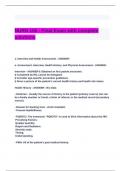NURN 155 - Final Exam with complete
solutions
1. Interview and Health Assessment - ANSWER-
a. Assessment- Interview, Health History, and Physical Assessment - ANSWER-
Interview - ANSWER-§ Obtained on first patient encounter.
§ Completed by RN, cannot be delegated.
§ Consider age-specific prevention guidelines.
§ Gives a picture of the patient's current health history and health risk status.
Health History - ANSWER-- Bio Data
- Historian - Usually the source of history is the patient (primary source), but can
be a family member or friend, a letter of referral, or the medical record (secondary
source).
- Reason for Seeking Care - chief complaint.
- Present Health/Illness.
- PQRSTU: The mnemonic ''PQRSTU'' is used to illicit information about the HPI.
Provoking Factors.
Quality/ quantity.
Region and Radiation.
Severity scale.
Timing.
Understanding.
- PMH: All of the patient's past medical history.
,- Family History - The health history of family members.
ROS - The nurse evaluates each body system's past and present state of health.
- Medication Reconciliation.
- ADL - The patient's ability to provide self care-bathing, toileting, walking, etc.
Physical Assessment - ANSWER-objective data: Observations or measurements
of the patient's health status.
Example- Checking Vital signs, nurse observing patient's behavior.
c. Health History-sources - ANSWER-Primary or Secondary Source:
•Patient.
•Family member.
•Observer.
•Caretaker.
•Health care team
•Electronic Medical Record (EMR).
•Other records- Immunization, educational, military, employment.
•Nurses Experience
d. Interview- Technique, sources, - ANSWER-Interview techniques:
§ Observation.
§ Open-ended Questions.
§ Closed-ended Questions.
§ Non-verbal skills - body language. I.e., posture, gesture, facial expression, eye
contact, foot tapping, touch etc.
d. Communication technique - ANSWER-• Sending - verbal and non-verbal
communication.
• Receiving - the receiver uses his or her own interpretations of your own words.
• Internal Factors- Respect, Empathy, Listening, Self-awareness
• External Factors- Privacy, No Interruptions, Environment
• Dress - the client must remain in street clothes when conducting the interview.
The interviewer's appearance should be appropriate to the setting.
• Note-taking - keep note-taking to a minimum.
e. Data collection- Subjective and Objective data, Open ended, closed ended -
ANSWER-• Subjective data - what the person says about himself or herself.
• Objective data - what the interviewer obtains through physical examination.
• Open-ended - allow clients to discuss their concerns freely.
, • Closed-ended - can be answered with "Yes" or "No," or they have a limited set
of possible answers.
2. General and Environmental survey, PA technique, documentation - ANSWER-
a. SWIPE - ANSWER-Safety/Survey, Wash your hands, Identify yourself & client,
Provide for privacy, and Explain.
b. General survey- Physical Appearance, Body structure, Mobility, and Behavior -
ANSWER-
Physical Appearance - ANSWER-1. Age- appears stated age.
2. Sex - sexual development is appropriate for sex and age.
3. Level of consciousness.
4. Skin Color - color tone is even, pigmentation varying with genetic background.
5. Facial Features - are symmetric with movement.
6. Overall appearance - no signs of acute distress are present.
Body Structure - ANSWER-1. Stature - the height appears within the normal range
for age and genetic heritage.
2. Nutritional Status - the weight appears within the normal range for height and
body build.
3. Symmetry - body parts are equal bilaterally and are in relative proportion.
4. Posture - the client stands comfortably erect as appropriate for their age.
5. Position/Deformities - posture and how the patient holds him/or herself is
surveyed.
Mobility - ANSWER-1. Gait - Descriptors of normal gait include: smooth, well-
balanced with symmetrical arm swings. The base of the gait should be as wide as
the shoulder width.
2. Range of Motion - note full mobility for each joint and that movement is
deliberate, accurate, smooth, and coordinated .
Behavior - ANSWER-1. Facial expression - the client maintains eye contact.
2. Mood and Affect - the client is comfortable and cooperative with the nurse and
interacts pleasantly.
3. Speech- Articulation clear.
4. Speech pattern - the stream of talking is fluent with an even pace.
5. Dress - clothing is appropriate to the climate, looks clean, fits the body, and is
appropriate to the client's culture and age group.




